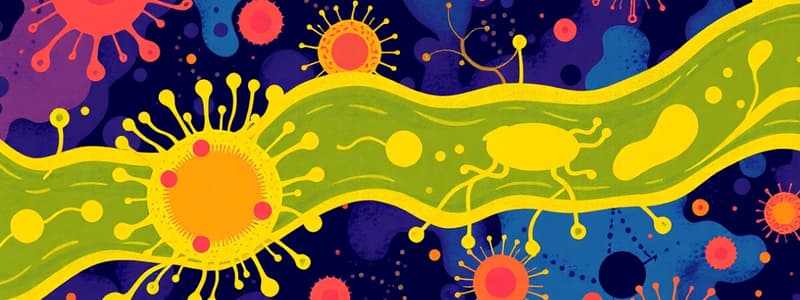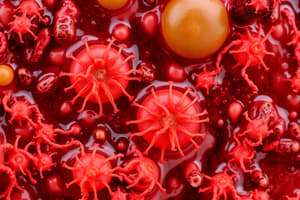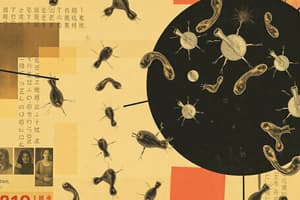Podcast
Questions and Answers
Which of the following is a characteristic of enriched media?
Which of the following is a characteristic of enriched media?
- It contains specific nutrients required for the growth fastidious organisms. (correct)
- It provides a general environment for the growth of a wide range of microorganisms.
- It inhibits the growth of certain microorganisms while allowing others to grow.
- It allows for the differentiation of microorganisms based on their metabolic properties.
Which type of microscopy uses a beam of electrons to illuminate the specimen and produce an image?
Which type of microscopy uses a beam of electrons to illuminate the specimen and produce an image?
- Dark-field microscopy
- Bright-field microscopy
- Phase-contrast microscopy
- Electron microscopy (correct)
What is the main difference between prokaryotes and eukaryotes?
What is the main difference between prokaryotes and eukaryotes?
- Prokaryotes lack membrane-bound organelles, while eukaryotes have them. (correct)
- Prokaryotes are always pathogenic, while eukaryotes are not.
- Prokaryotes are unicellular, while eukaryotes are multicellular.
- Prokaryotes have a nucleus, while eukaryotes do not.
Which of the following is NOT a type of differential staining?
Which of the following is NOT a type of differential staining?
Which technique is used to isolate individual bacterial colonies from a mixed culture?
Which technique is used to isolate individual bacterial colonies from a mixed culture?
What does the term 'sterilization' refer to?
What does the term 'sterilization' refer to?
Which of the following is a nonsynthetic/complex medium?
Which of the following is a nonsynthetic/complex medium?
Which of the following is considered a beneficial aspect of microorganisms?
Which of the following is considered a beneficial aspect of microorganisms?
Flashcards
Pathogen
Pathogen
An organism that causes disease in its host.
Sterilization
Sterilization
The process of eliminating all microorganisms from an object or area.
Beneficial microorganisms
Beneficial microorganisms
Microbes that provide health benefits, like aiding digestion.
Spontaneous generation
Spontaneous generation
Signup and view all the flashcards
Germ theory of disease
Germ theory of disease
Signup and view all the flashcards
Prokaryotes vs. Eukaryotes
Prokaryotes vs. Eukaryotes
Signup and view all the flashcards
Chemically-defined media
Chemically-defined media
Signup and view all the flashcards
Isolation in microbiology
Isolation in microbiology
Signup and view all the flashcards
Study Notes
Chapter 1
- Pathogen: Definition of a pathogen.
- Infectious Diseases: Most common causes worldwide.
- Historical Comparison: Differences in disease causes in the U.S. today vs. 100+ years ago, and US vs. worldwide.
- Microorganisms: Beneficial aspects.
- Microbial Pioneers: Contributions of Antoni van Leeuwenhoek, Louis Pasteur, and Robert Koch to microbiology.
- Spontaneous Generation: Definition.
- Germ Theory of Disease: Definition.
- Nomenclature: Scientific naming and writing of names.
- Three Domains of Life: Bacteria, Archaea, Eukarya—identifying prokaryotes.
- Prokaryote/Eukaryote Differences: Explaining the difference.
- Extremophiles: Archaea as extremophiles (extreme-loving microorganisms).
Chapter 3
- Definitions: Inoculation, Incubation, Isolation, Culture, Colony.
- Media:
- Chemically-Defined vs. Nonsynthetic/Complex media
- General Purpose media: definition and examples.
- Enriched media: Definition and examples (e.g., media with added nutrients to grow fastidious organisms).
- Selective media: Definition and examples.
- Differential media: Definition and examples.
- Why certain media types are enriched, selective, and differential.
- Colony Isolation: Streak plate method.
- Agar: Properties and uses.
- Microscopy:
- Bright-field vs. Dark-field vs. Phase-contrast vs. Fluorescent vs. Electron microscopes: purpose, image appearance, illumination source, and sample size differences.
- Positive vs. negative staining.
- Simple vs. Differential vs. Structural staining: purpose, types, and examples.
- Images (on the Exam):
- Types of Staining.
- Types of Microscopy.
- Types of Culture.
Studying That Suits You
Use AI to generate personalized quizzes and flashcards to suit your learning preferences.




